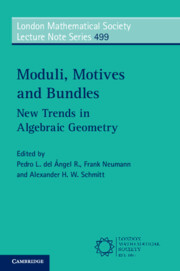Book contents
- Frontmatter
- Contents
- Contributors
- Preface
- 1 On the Stack of 0-Dimensional Coherent Sheaves: Structural Aspects
- 2 Three Lectures on Quadratic Enumerative Geometry
- 3 Flat Torsors in Complex Geometry
- 4 Universal Chern Classes on the Moduli of Bundles
- 5 Linear Stability of Coherent Systems and Applications to Butler’s Conjecture
- 6 A Kobayashi–Hitchin Correspondence for General Coherent Systems
- 7 On the Injectivity and Non-injectivity of the l-Adic Cycle Class Maps
- 8 A Primer on Zeta Functions and Decomposition Spaces
- 9 Atiyah–Bott Localization in Equivariant Witt Cohomology
- 10 Base Loci, Semiampleness, and Parallelizable Manifolds
- 11 Recent Developments on Compactifications of Stacks of Shtukas
- 12 A Common Generalisation of the André–Oort and André–Pink–Zannier Conjectures
- References
5 - Linear Stability of Coherent Systems and Applications to Butler’s Conjecture
Published online by Cambridge University Press: 31 October 2025
- Frontmatter
- Contents
- Contributors
- Preface
- 1 On the Stack of 0-Dimensional Coherent Sheaves: Structural Aspects
- 2 Three Lectures on Quadratic Enumerative Geometry
- 3 Flat Torsors in Complex Geometry
- 4 Universal Chern Classes on the Moduli of Bundles
- 5 Linear Stability of Coherent Systems and Applications to Butler’s Conjecture
- 6 A Kobayashi–Hitchin Correspondence for General Coherent Systems
- 7 On the Injectivity and Non-injectivity of the l-Adic Cycle Class Maps
- 8 A Primer on Zeta Functions and Decomposition Spaces
- 9 Atiyah–Bott Localization in Equivariant Witt Cohomology
- 10 Base Loci, Semiampleness, and Parallelizable Manifolds
- 11 Recent Developments on Compactifications of Stacks of Shtukas
- 12 A Common Generalisation of the André–Oort and André–Pink–Zannier Conjectures
- References
Summary
The notion of linear stability of a variety in projective space was introduced by Mumford in the context of GIT. It has subsequently been applied by Mistretta and others to Butler’s conjecture on stability of the dual span bundle (DSB) MV,E of a general generated coherent system (E,V)
. We survey recent progress in this direction on rank one coherent systems, prove a new result for hyperelliptic curves, and state some open questions. We then extend the definition of linear stability to generated coherent systems of higher rank. We show that various coherent systems with unstable DSB studied in \cite{bmno} are also linearly unstable. We show that linearly stable coherent systems of type (2, d, 4) for low enough d have stable DSB, and use this to prove a particular case of Butler’s conjecture. We then exhibit a linearly stable generated coherent system with unstable DSB, confirming that linear stability of (E,V)
in general remains weaker than semistability of MV,E
in higher rank. We end with a list of open questions on the higher rank case.
Information
- Type
- Chapter
- Information
- Moduli, Motives and BundlesNew Trends in Algebraic Geometry, pp. 157 - 182Publisher: Cambridge University PressPrint publication year: 2025
References
Accessibility standard: Inaccessible, or known limited accessibility
Why this information is here
This section outlines the accessibility features of this content - including support for screen readers, full keyboard navigation and high-contrast display options. This may not be relevant for you.Accessibility Information
Content Navigation
Allows you to navigate directly to chapters, sections, or non‐text items through a linked table of contents, reducing the need for extensive scrolling.
Provides an interactive index, letting you go straight to where a term or subject appears in the text without manual searching.
Reading Order & Textual Equivalents
You will encounter all content (including footnotes, captions, etc.) in a clear, sequential flow, making it easier to follow with assistive tools like screen readers.
You get concise descriptions (for images, charts, or media clips), ensuring you do not miss crucial information when visual or audio elements are not accessible.
